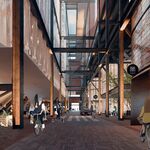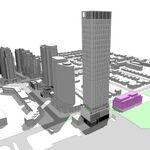From the Apr. 2 edition of
eyeweekly.com
Overdue justice
Finally, restitution for the crimes against Jarvis is at hand
BY SHAWN MICALLEF April 01, 2009 21:04
On February 20, at 8:02am, city councillor Denzil Minnan-Wong tweeted “Used the middle lane on Jarvis St to get to work. Fast and efficient!†When questioned he said, “It was a great way to get to work. Imagine driving to work and not having to wait in gridlock! It was fantastic!â€
The exclamation-mark-mad muckraking councillor was intentionally wading into the contentious debate about the future of Jarvis. At the same time, he betrayed the strange panic that causes car drivers to think anything taming the dominance of the automobile on urban design is somehow a declaration of war on the car.
Jarvis, once the most beautiful street in Toronto, has been reverse-gentrified and turned into a fat arterial traffic pipe between North Toronto and downtown. The City’s Jarvis Street Improvement Plan, championed by local councillor Kyle Rae, aims to return the street to some of its pedestrian-friendly glory.
Back in deep winter, it was evident those who want to keep Jarvis the way it is were upset. In the Globe and Mail on Feb. 7, Rosedale resident Rob McEwen was apoplectic, saying “It’s coming out of the blue. I never heard a thing about it. You don’t just drop something like this on people’s laps.†The shrill tone of Mr. McEwen’s histrionics might lead one to believe the city wants to close Jarvis and hand it over to ambulatory south-of-Bloor Bolsheviks.
This, of course, is not the case and as early as 2000 Rae told Christopher Hume of the Star, “What we’re trying to do is bring back something the city lost many years ago... a dignified and safe street with a park and a boulevard.†This includes wider sidewalks, more trees and possibly a bike lane, but the main item fanning Rosedale’s rhetorical flames is the removal of Jarvis’ unique middle lane, which reverses direction depending on the rush hour flow.
Recently, Rae has suggested it’s “going to get ugly,†but points out that the McEwens and Minnan-Wongs of Toronto haven’t noticed the “residential urbanization that has happened around Jarvis south of Bloor in the last few decades.†It’s easy to miss speed by in a car. Walk Jarvis, and you quickly notice the incredible residential density, and how much of its past grandeur still remains.
Today, Jarvis begins in a different kind of grandeur, along Bloor’s Insurance Company Row. The Rogers headquarters was once Confederation Life, a company that went under in 1994, long before insurance company failure was bailout-fashionable. Here, Mt. Pleasant Road, opened in the early 1950s (once referred to as the city’s first expressway) funnels all that Rosedale and North Toronto traffic onto Jarvis. The traffic eventually pressured planners to remove trees and widen Jarvis in the 1960s.
Just south and opposite Rogers is a block of wonderful mid-century modern apartment buildings with angular yellow brick and glass that look as sharp as Glenn Gould’s Goldberg Variations of the same era sound. One is appropriately named “Massey House,†as the Massey family lived just down the street in what is now the Keg Mansion. To understand the Jarvis story, stand across from the Keg at the corner of Cawthra Square. From there, you will see two massive Richardson Romanesque mansions (that look like smaller versions of Old City Hall), high-rise and low-rise apartment buildings and Jarvis Collegiate south of Wellesley, where so many Torontonians of note went and where so many Canadians of future note currently attend. All good things, but in front of that celebrated Keg Mansion is one of Toronto’s ugliest parking lots, there like a blunt piece of public art representing the crimes against Jarvis.
Nearby, the details that make Jarvis great are many. At Wellesley, on the northeast corner, “Plaza 100†— a narrow, wide and high concrete building complete with rooftop swimming pool — is surrounded by mod parkettes defined by Expo ’67–era avant-garde sculptural shapes. Sit on one of the benches and the potential of Jarvis to return to its former, welcoming state is obvious.
Until I walked Jarvis to write this — that is, until I paid attention to the street — I hadn’t noticed that just south of Wellesley at 440 is the Hincks-Dellcrest Centre, a children’s mental health facility and brutalist masterpiece tucked away behind some trees. More details follow a few steps down at 432-438 where the Jarvis Court apartments have gorgeous pre-war de Stijl tile and window designs. Across the street, round apartment towers rise behind a Second Empire mansion that could have been the inspiration for the house in Hitchcock’s Psycho. At this point, Jarvis begins to seem like it should be a cherished architectural museum rather than Toronto’s shortcut.
The most recent celebrated jewel in Jarvis’ heretofore secret crown of gems is the Canadian National Ballet School, a perfect collision of new and old, with glass and steel surrounding old mansions and the former CBC headquarters, itself once the Havergal school for girls. The condo towers that rise behind — appropriately named Radio City — are simply the latest additions to this dense, residential neighbourhood.
South of Carlton, Jarvis begins to look more fortified. The Inglewood Arms rents rooms daily and weekly, Allan Gardens has an underwhelming street presence, the traditional downtown sex-worker “stroll†is here — guys in cars really do drive slowly in the evening looking at the sidewalk like they’re extras in Taxi Driver — and the fenced-in Moss Park Armoury is a bad urban neighbour.
Still, old mansions, townhomes and newer residential buildings continue along Jarvis to the St. Lawrence neighbourhood where there is no questioning the street’s vibrancy. Here Jarvis no longer has the magic centre lane and traffic is forced to squeeze into two lanes — even one lane during non-rush-hour times. All this fuss over a street that isn’t really a highway after all?
Politically, Kyle Rae knows that even though the drivers on Jarvis outnumber the residents, the people who vote for him all live in the neighbourhood. And considering Jarvis’ historic role as a beautiful street, and the potential its revitalization has to improve the rest of the downtown east side, it’s the right thing to do. Cars will still pass through, war will not have been declared and Toronto will be better off.
One day soon, the good people of Ward 34 Don Valley East are also going to start demanding beautiful, more pedestrian-friendly streets from their councillor. What will Minnan-Wong tweet then?




